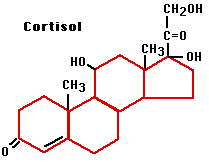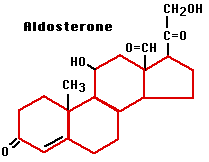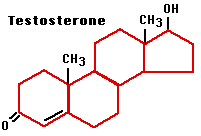| Index to this page |
The adrenal glands are two small structures situated one atop each kidney.
Both in anatomy and in function, they consist of two distinct regions:| Link to graphic showing the location and structure of the adrenal glands (92K). |
Production of all three classes is triggered by the secretion of ACTH from the anterior lobe of the pituitary.
These hormones achieve their effects by:| Discussion of mechanism |

The glucocorticoids get their name from their effect of raising the level of blood sugar (glucose). One way they do this is by stimulating gluconeogenesis in the liver: the conversion of fat and protein into intermediate metabolites that are ultimately converted into glucose.
The most abundant glucocorticoid is cortisol (also called hydrocortisone).
Cortisol and the other glucocorticoids also have a potent anti-inflammatory effect on the body. They depress the immune response, especially cell-mediated immune responses. [Discussion of mechanism]
For this reason glucocorticoids are widely used in therapy:
The mineralocorticoids get their name from their effect on mineral metabolism. The most important of them is the steroid aldosterone.
Aldosterone acts on the kidney promoting the reabsorption of sodium ions (Na+) into the blood. Water follows the salt and this helps maintain normal blood pressure.
| Link to discussion. |
Aldosterone also
 The adrenal cortex secretes precursors to androgens such as testosterone.
The adrenal cortex secretes precursors to androgens such as testosterone.
In sexually-mature males, this source is so much lower than that of the testes that it is probably of little physiological significance. However, excessive production of adrenal androgens can cause premature puberty in young boys.
In females, the adrenal cortex is a major source of androgens. Their hypersecretion may produce a masculine pattern of body hair and cessation of menstruation.
The essential role of the adrenal hormones means that a deficiency can be life-threatening. Fortunately, replacement therapy with glucocorticoids and mineralocorticoids can permit a normal life.
In Cushing's disease, the level of glucocorticoids, especially cortisol, is too high.
It can be caused by:The adrenal medulla consists of masses of neurons that are part of the sympathetic branch of the autonomic nervous system. Instead of releasing their neurotransmitters at a synapse, these neurons release them into the blood. Thus, although part of the nervous system, the adrenal medulla functions as an endocrine gland.
The adrenal medulla releases:Both are derived from the amino acid tyrosine.
Release of adrenaline and noradrenaline is triggered by nervous stimulation in response to physical or mental stress. The hormones bind to adrenergic receptors — transmembrane proteins in the plasma membrane of many cell types.
Some of the effects are:| Welcome&Next Search |